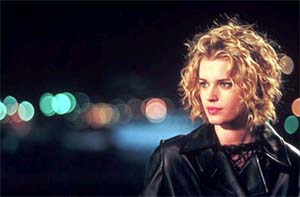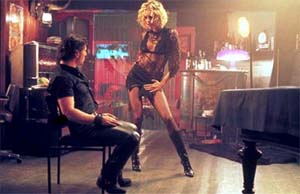
|
"Wipe it off!" commands Laure Ash (Rebecca Romijn-Stamos) to Nicolas Bardo (Antonio Banderas) in one of an infinite intimate sexual embarrassments De Palma gets off in his inspired screenplay. It's like shooting fish in a fish tank for this master filmmaker, at last enjoying the freedom in Europe he rarely got in Hollywood. De Palma swings that freedom around, showing off his narrative audacity - a big "Go fuck yourself!" to test-screening Hollywood. Femme Fatale propels its characters and audience through time-jumping and time-freezing plots-within-plots-within-plots. Through it all, the audience flies high on De Palma's fairy-godmother wings and crystal-ball clarity. The characters, however, don't know if they're sinking or swimming. That's how Nicolas feels, caught in Laure's snatch. It's also true of Laure's deeply examined moral trap. Catch how "rotten-to-the-heart" jewel thief Laure fish-hooks photographer Nicolas: "All your boyhood stories make you so damn loveable." That is fatale! De Palma so understands fragile male egos, only he could create the ultimate Femme Fatale. Lady-in-the-lake Laure's destiny connects - via soul suture - to that of (body) double Lily (Romijn-Stamos again). Lily is distraught over the death of her husband and daughter and the consequent demise of her sense of self, as constructed in family photographs. Lily also mourns for Laure and Nicolas, for their desperate patsies-in-Hell maneuvering through gender roles and sexual types, image-making and image-watching. They're shadows of their true selves. Romijn-Stamos' draw'-dropping double-duty performance steps into the light. She models for De Palma's cinematically rendered compassion - p.o.v. shots and emotionally resonant images. This model-turned-actress evinces her own character-empathy for the palpable enjoyment of De Palma's camera.
Indeed, every shot of the film requires unusually vitalizing work and imagination from spectators. Fear not. It pays off like a money shot. "Femme Fatale" has more ejaculations than a porn flick. Penetrations, orifices, and phalluses abound unbound - including cinematographer Thierry Arbogast's caressing camera movements, vertiginous angles, and aureole lighting. The pleasure and the philosophy of Femme Fatale requires the spectator to participate in De Palma's elaborately perverse visual game of "Deja Vue". "This isn't a game. People can die," warns Black Tie (Eriq Ebouaney), the leader of a gang of jewel thieves. Call it ideological Russian Roulette. And that character should know it. Ebouaney gives an erotically-charged performance, whipping out his Black tazer and zapping audience expectations about race and sex at the movies (a location as seemingly innocuous as a men's room urinal). "Stop dreaming, bitch!" he slaps Laure in the film's opening shot - a taboo-busting frisson. In Femme Fatale, the ecstasy of engaging images of exponential meaning is experienced as erotic reverie, unfettered by narrative or ideological containment. That very imaginative rite - faith - is De Palma's benediction-by-orgasm. A striptease performed by Laure/Romijn-Stamos makes explicit the meta-sexual basis of all of De Palma's classic action set-pieces - structural orgasms. It sums up his career so that the rest of Femme Fatale can go beyond it. Choreographed to Damien Saez's serpentine-sleek "Sexe", it even replays the film's earlier Cannes Film Fest jewel-heist ballet of sexual signifiers, movie-watching, and steamy lesbian sex set to Ryuichi Sakamoto's genre-jaunty take on Ravel's "Bolero."
 Every image in the striptease (psycho)analyzes spectator and spectacle.
Laure's seven-veils dance incites Nicolas' show of macho violence -
projected as a shadow on the wall. De Palma exposes how misogyny and
cynicism are reflected in, and manipulated by, movies. The femme fatales and
male patsies of film noir offer illusory allure cut with real-world
consequences - Hollywood's Double Indemnity clause.
Every image in the striptease (psycho)analyzes spectator and spectacle.
Laure's seven-veils dance incites Nicolas' show of macho violence -
projected as a shadow on the wall. De Palma exposes how misogyny and
cynicism are reflected in, and manipulated by, movies. The femme fatales and
male patsies of film noir offer illusory allure cut with real-world
consequences - Hollywood's Double Indemnity clause.
De Palma's baroque sensuality isn't just more fun than most movies, it's more honest - and, ultimately, redemptive. Because they exude such liberating PoMo intensity - the sexual-spiritual essence that cannot be contained - De Palma's images have to be this HOT. That openness to the eroticism of signs - as when long-haired Banderas and short-cropped Romijn-Stamos kiss in profile - makes for a mind-blowing, soul-soaring sexual Epic. De Palma criticizes the use of movies as subjective fantasy. It's exemplified in the images of Romijn-Stamos' expressionist smile and Banderas' bloody smirk - an auto-critique of De Palma's infamous alligator grin. Like a prayer answered, De Palma flips the script and fulfills the benevolent potential of his art. Femme Fatale offers the phenomenon of emotion, of feeling, of Love. At the heart of his tale-chasing, De Palma discovers a fundamental moral dilemma. He dramatizes - from recoil to redemption - the spectator's existential relationship to cinema. Doing so, De Palma validates the spiritual pain and potential of his characters - and his audience. It is never only a dream - and never only a movie. Moral action, spiritual pursuit, sexual license result in catharsis and healing - De Palma's divine faith in a movie audience that won't leave before the film is over, that goes to movies with eyes agape for miracles. Femme Fatale performs a spiritual striptease. It is De Palma's masterwork. |
|
 Laure Ash (Rebecca Romijn-Stamos) tempts Nicolas Bardo
(Antonio Banderas) in Femme Fatale
Laure Ash (Rebecca Romijn-Stamos) tempts Nicolas Bardo
(Antonio Banderas) in Femme Fatale  Brian De Palma with Rebecca Romijn Stamos and Antonio Banderas on the set of Femme Fatale
Brian De Palma with Rebecca Romijn Stamos and Antonio Banderas on the set of Femme Fatale